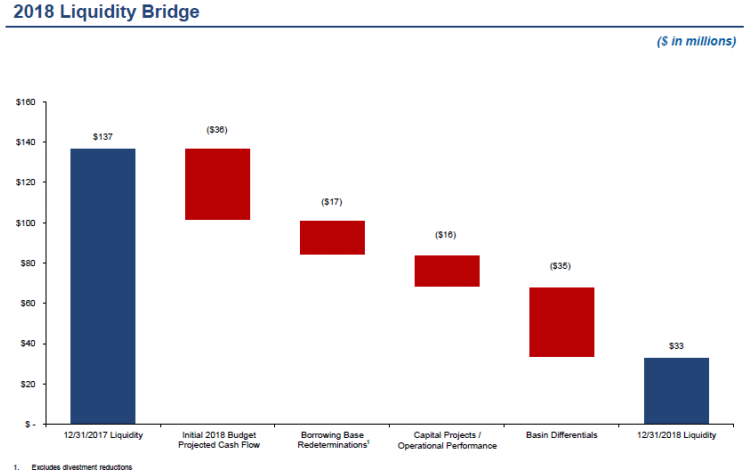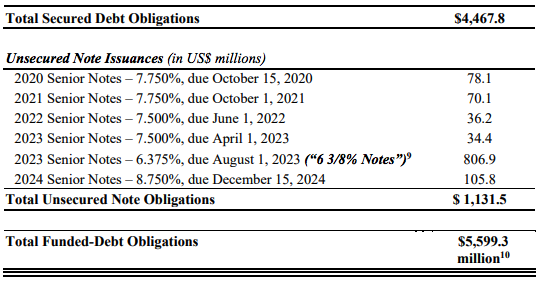New Chapter 11 Filing - Hexion Holdings LLC
Hexion Holdings LLC
April 1, 2019
What we appreciate that and, we hope thanks to PETITION, others will eventually come to appreciate, is that there is a lot to learn from the special corporate law, investment banking, advisory, and investing niche labeled “restructuring” and “distressed investing.” Here, Ohio-based Hexion Holdings LLC is a company that probably touches our lives in ways that most people have no knowledge of: it produces resins that “are key ingredients in a wide variety of industrial and consumer goods, where they are often employed as adhesives, as coatings and sealants, and as intermediates for other chemical applications.” These adhesives are used in wind turbines and particle board; their coatings prevent corrosion on bridges and buildings. You can imagine a scenario where, if Washington D.C. can ever get its act together and get an infrastructure bill done, Hexion will have a significant influx of revenue.
Not that revenue is an issue now. It generated $3.8b in 2018, churning out $440mm of EBITDA. And operational performance is on the upswing, having improved 21% YOY. So what’s the problem? In short, the balance sheet is a hot mess.* Per the company:
“…the Debtors face financial difficulties. Prior to the anticipated restructuring, the Debtors are over nine times levered relative to their 2018 adjusted EBITDA and face annual debt service in excess of $300 million. In addition, over $2 billion of the Debtors’ prepetition funded debt obligations mature in 2020. The resulting liquidity and refinancing pressures have created an unsustainable drag on the Debtors and, by extension, their Non-Debtor Affiliates, requiring a comprehensive solution.”
This is what that capital structure looks like:
(PETITION Note: if you’re wondering what the eff is a 1.5 lien note, well, welcome to the party pal. These notes are a construct of a frothy high-yield market and constructive readings of credit docs. They were issued in 2017 to discharge maturing notes. The holders thereof enjoy higher priority on collateral than the second lien notes and other junior creditors below, but slot in beneath the first lien notes).
Anyway, to remedy this issue, the company has entered into a support agreement “that enjoys the support of creditors holding a majority of the debt to be restructured, including majorities within every tier of the capital structure.” The agreement would reduce total funded debt by $2b by: (a) giving the first lien noteholders $1.45b in cash (less adequate protection payments reflecting interest on their loans), and 72.5% of new common stock and rights to participate in the rights offering at a significant discount to a total enterprise value of $3.1b; and (b) the 1.5 lien noteholders, the second lien noteholders and the unsecured noteholders 27.5% of the new common stock and rights to participate in the rights offering. The case will be funded by a $700mm DIP credit facility.
*Interestingly, Hexion is a derivative victim of the oil and gas downturn. In 2014, the company was selling resin coated sand to oil and gas businesses to the tune of 8% of sales and 28% of segment EBITDA. By 2016, segment EBITDA dropped by approximately $150mm, a sizable loss that couldn’t be offset by other business units.
Jurisdiction: D. of Delaware (Judge Gross)
Capital Structure: See above.
Professionals:
Legal: Latham & Watkins LLP (George Davis, Andrew Parlan, Hugh Murtagh, Caroline Reckler, Jason Gott, Lisa Lansio, Blake Denton, Andrew Sorkin, Christopher Harris) & (local) Richards Layton & Finger PA (Mark Collins, Michael Merchant, Amanda Steele, Brendan Schlauch)
Managers: Samuel Feinstein, William Joyce, Robert Kaslow-Ramos, George F. Knight III, Geoffrey Manna, Craig Rogerson, Marvin Schlanger, Lee Stewart
Financial Advisor: AlixPartners LLP
Investment Banker: Moelis & Company LLC (Zul Jamal)
Claims Agent: Omni Management Group (*click on the link above for free docket access)
Other Parties in Interest:
Ad Hoc Group of First Lien Noteholders (Angelo Gordon & Co. LP, Aristeia Capital LLC, Barclays Bank PLC, Beach Point Capital Management LP, Capital Research and Management Company, Citadel Advisors LLC, Contrarian Capital Management LLC, Credit Suisse Securities USA LLC, Davidson Kempner Capital Management LP, DoubleLine Capital LP, Eaton Vance Management, Federated Investment Counseling, GoldenTree Asset Management LP, Graham Capital Management LP, GSO Capital Partners LP, Heyman Enterprise LLC, Hotchkis and Wiley Capital Management LLC, OSK VII LLC, Pacific Investment Management Company LLC, Silver Rock Financial LP, Sound Point Capital Management LP, Tor Asia Credit Master Fund LP, UBS Securities LLC, Whitebox Advisors LLC)
Legal: Akin Gump Strauss Hauer & Feld LLP (Ira Dizengoff, Philip Dublin, Daniel Fisher, Naomi Moss, Abid Qureshi)
Financial Advisor: Evercore Group LLC
Ad Hoc Group of Crossover Noteholders (Aegon USA Investment Management LLC, Aurelius Capital Master Ltd., Avenue Capital Management II LP, Avenue Europe International Management, Benefit Street Partners LLC, Cyrus Capital Partners LP, KLS Diversified Asset Management LLC, Loomis Sayles & Company LP, Monarch Alternative Capital LP, New Generation Advisors LLC, P. Schoenfeld Asset Management LP)
Legal: Milbank LLP (Samuel Khalil, Matthew Brod)
Financial Advisor: Houlihan Lokey Capital Inc.
Ad Hoc Group of 1.5 Lien Noteholders
Legal: Jones Day (Sidney Levinson, Jeremy Evans)
Pre-petition RCF Agent & Post-petition DIP Agent ($350mm): JPMorgan Chase Bank NA
Legal: Simpson Thacher & Bartlett LLP
Trustee under the First Lien Notes: U.S. Bank NA
Legal: Kelley Drye & Warren LLP (James Carr, Kristin Elliott) & (local) Dorsey & Whitney LLP (Eric Lopez Schnabel, Alessandra Glorioso)
Trustee of 1.5 Lien Notes: Wilmington Savings Fund Society FSB
Legal: Arnold & Porter Kaye Scholer LLP
Trustee of Borden Indentures: The Bank of New York Mellon
Sponsor: Apollo
Official Committee of Unsecured Creditors: Pension Benefit Guaranty Corporation; Agrium US, Inc.; The Bank of New York Mellon; Mitsubishi Gas Chemical America; PVS Chloralkali, Inc.; Southern Chemical Corporation; Wilmington Trust; Wilmington Savings Fund Society; and Blue Cube Operations LLC
Legal: Kramer Levin Naftalis & Frankel LLP (Kenneth Eckstein, Douglas Mannal, Rachael Ringer) & (local) Bayard PA (Scott Cousins, Erin Fay, Gregory Flasser)
Financial Advisor: FTI Consulting Inc. (Samuel Star)
Updated:














